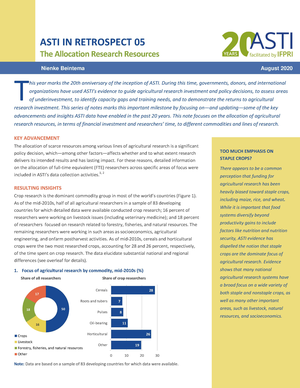Authors:
Nienke Beintema
Year:
2020
Publisher
International Food Policy Research Institute
Back to:
2020 marks the 20th anniversary of the inception of ASTI. To highlight this important milestone, the program released a Series of Notes focusing on—and updating—some of the key advancements and insights ASTI data have enabled in the past 20 years. This note focuses on the allocation of agricultural research resources, in terms of financial investment and researchers’ time, to different commodities and lines of research.
The allocation of scarce resources among various lines of agricultural research is a significant policy decision, which—among other factors—affects whether and to what extent research delivers its intended results and has lasting impact. For these reasons, detailed information on the allocation of full-time equivalent (FTE) researchers across specific areas of focus were included in ASTI’s data collection activities.
Crop research is the dominant commodity group in most of the world’s countries. As of the mid-2010s, half of all agricultural researchers in a sample of 83 developing countries for which detailed data were available conducted crop research; 16 percent of researchers were working on livestock issues (including veterinary medicine); and 18 percent of researchers focused on research related to forestry, fisheries, and natural resources. The remaining researchers were working in such areas as socioeconomics, agricultural engineering, and onfarm postharvest activities. As of mid-2010s, cereals and horticultural crops were the two most researched crops, accounting for 28 and 26 percent, respectively, of the time spent on crop research. The data reveal substantial national and regional differences.

